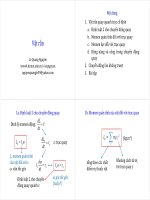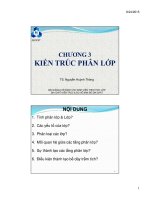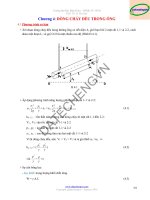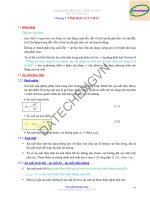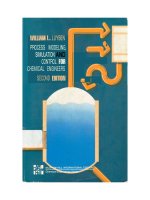Giao trinh bai tap ds0intro
Bạn đang xem bản rút gọn của tài liệu. Xem và tải ngay bản đầy đủ của tài liệu tại đây (5.76 MB, 86 trang )
U.S. Department of Labor
Occupational Safety & Health Administration
[skip navigational links]
Home
General Safety
Site Preparation
Drilling
Search
Advanced Search
Well Completion
Servicing
Plug and Abandon the Well
Illustrated Glossary
Drilling Rig Components
Click on the name below or a number on the
graphic to see a definition and a more detailed
photo of the object.
1.
2.
3.
4.
5.
6.
7.
8.
9.
10.
11.
12.
13.
14.
15.
16.
17.
18.
19.
20.
21.
22.
23.
24.
25.
Crown Block and Water Table
Catline Boom and Hoist Line
Drilling Line
Monkeyboard
Traveling Block
Top Drive
Mast
Drill Pipe
Doghouse
Blowout Preventer
Water Tank
Electric Cable Tray
Engine Generator Sets
Fuel Tank
Electrical Control House
Mud Pumps
Bulk Mud Component Tanks
Mud Tanks (Pits)
Reserve Pit
Mud-Gas Separator
Shale Shakers
Choke Manifold
Pipe Ramp
Pipe Racks
Accumulator
Additional rig components not illustrated at right.
26.
27.
28.
29.
30.
31.
32.
33.
34.
35.
36.
Annulus
Brake
Casing Head
Cathead
Catwalk
Cellar
Conductor Pipe
Degasser
Desander
Desilter
Drawworks
Equipment used in drilling
48.
49.
50.
Ram BOP
Rathole
Rotary Hose
| A-Z Index
37.
38.
39.
40.
41.
42.
43.
44.
45.
46.
47.
Drill Bit
Drill Collars
Driller's Console
Elevators
Hoisting Line
Hook
Kelly
Kelly Bushing
Kelly Spinner
Mousehole
Mud Return Line
51.
52.
53.
54.
55.
56.
57.
58.
59.
60.
61.
Rotary Table
Slips
Spinning chain
Stairways
Standpipe
Surface Casing
Substructure
Swivel
Tongs
Walkways
Weight Indicator
eTool Home | Site Preparation | Drilling | Well Completion | Servicing | Plug & Abandon Well
General Safety | Additional References | Viewing/Printing Instructions | Credits | JSA
Safety and Health Topic | Site Map | Illustrated Glossary | Glossary of Terms
www.osha.gov
Back to Top
Contact Us
| Freedom of Information Act | Information Quality | Customer Survey
Privacy and Security Statement | Disclaimers
Occupational Safety & Health Administration
200 Constitution Avenue, NW
Washington, DC 20210
www.dol.gov
U.S. Department of Labor
Occupational Safety & Health Administration
[skip navigational links]
Home
General Safety
Site Preparation
Drilling
Illustrated Glossary
Accumulator
The storage device for nitrogen pressurized
hydraulic fluid, which is used in operating the
blowout preventers.
Annular Blowout Preventer
A large valve, usually installed above the ram preventers,
that forms a seal in the annular space between the pipe
and well bore. If no pipe is present, it forms a seal on the
well bore itself.
Annulus
The space around a pipe in a well bore, the outer wall of
which may be the wall of either the bore hole or the
casing; sometimes termed the annular space.
Search
Well Completion
Advanced Search
Servicing
| A-Z Index
Plug and Abandon the Well
Blowout Preventer
A large valve, usually installed above the ram preventers,
that forms a seal in the annular space between the pipe
and well bore or, if no pipe is present, on the well bore
itself.
Brake
The braking device on the drawworks to stop a load being
lifted.
Bulk Mud Components in Storage
Hopper type tanks for storage of drilling fluid components.
Casing Head
A heavy, flanged steel fitting connected to the first string
of casing. It provides a housing for slips and packing
assemblies, allows suspension of intermediate and
production strings of casing, and supplies the means for
the annulus to be sealed off. Also called a spool.
Cathead
A spool-shaped attachment on a winch around which rope
for hoisting and pulling is wound.
Catline Boom and Hoist Line
A structural framework erected near the top of the derrick
for lifting material.
Catwalk
The ramp at the side of the drilling rig where pipe is laid to
be lifted to the derrick floor by the catline or by an air
hoist.
Cellar
A pit in the ground to provide additional height between
the rig floor and the well head to accommodate the
installation of blowout preventers, ratholes, mouseholes,
and so forth. It also collects drainage water and other
fluids for disposal.
Choke Manifold
The arrangement of piping and special valves, called
chokes, through which drilling mud is circulated when the
blowout preventers are closed to control the pressures
encountered during a kick.
Conductor Pipe
The largest diameter casing and the topmost length of
casing. It is relatively short and encases the topmost
string of casing.
Crown Block and Water Table
An assembly of sheaves or pulleys mounted on beams at
the top of the derrick. The drilling line is run over the
sheaves down to the hoisting drum.
Degasser
The equipment used to remove unwanted gas from a
liquid, especially from drilling fluid.
Desander
A centrifugal device for removing sand from drilling fluid to
prevent abrasion of the pumps. It may be operated
mechanically or by a fast -moving stream of fluid inside a
special cone-shaped vessel, in which case it is sometimes
called a hydrocyclone.
Desilter
A centrifugal device, similar to a desander, used to remove
very fine particles, or silt, from drilling fluid. This keeps
the amount of solids in the fluid to the lowest possible
level.
Doghouse
A small enclosure on the rig floor used as an office for the
driller or as a storehouse for small objects. Also, any small
building used as an office or for storage.
Drawworks
The hoisting mechanism on a drilling rig. It is essentially a
large winch that spools off or takes in the drilling line and
thus raises or lowers the drill stem and bit.
Drill Bit
The cutting or boring element used in drilling oil and gas
wells. Most bits used in rotary drilling are roller-cone bits.
The bit consists of the cutting elements and the circulating
element. The circulating element permits the passage of
drilling fluid and uses the hydraulic force of the fluid
stream to improve drilling rates.
Drill Collar
A heavy, thick-walled tube, usually steel, used between
the drill pipe and the bit in the drill stem. It is used to put
weight on the bit so that the bit can drill.
Drill Pipe
The heavy seamless tubing used to rotate the bit and
circulate the drilling fluid. Joints of pipe 30 feet long are
coupled together with tool joints.
Driller's Console
The control panel, located on the platform, where the
driller controls drilling operations.
Drilling Line
A wire rope hoisting line, reeved on sheaves of the crown
block and traveling block (in effect a block and tackle). Its
primary purpose is to hoist or lower drill pipe or casing
from or into a well. Also, a wire rope used to support the
drilling tools.
Electric Control House
On diesel electric rigs, powerful diesel engines drive large
electric generators. The generators produce electricity that
flows through cables to electric switches and control
equipment enclosed in a control cabinet or panel.
Electricity is fed to electric motors via the panel.
Electric Cable Tray
Supports the heavy electrical cables that feed the power
from the control panel to the rig motors.
Elevators
A set of clamps that grips a stand, or column, of casing,
tubing, drill pipe, or sucker rods, so the stand can be
raised or lowered into the hole.
Engine Generator Sets
A diesel, Liquefied Petroleum Gas (LPG), natural gas, or
gasoline engine, along with a mechanical transmission and
generator for producing power for the drilling rig. Newer
rigs use electric generators to power electric motors on
the other parts of the rig.
Fuel Tanks
Fuel storage tanks for the power generating system.
Hoisting Line
A wire rope used in hoisting operations. Must conform to
the API standards for its intended uses.
Hook
A large, hook-shaped device from which the elevator bails
or the swivel is suspended. It is designed to carry
maximum loads ranging from 100 to 650 tons and turns
on bearings in its supporting housing.
Kelly
The heavy square or hexagonal steel member suspended
from the swivel through the rotary table. It is connected to
the topmost joint of drill pipe to turn the drill stem as the
rotary table turns.
Kelly Bushing
A device fitted to the rotary table through which the kelly
passes. It is the means by which the torque of the rotary
table is transmitted to the kelly and to the drill stem. Also
called the drive bushing.
Kelly Spinner
A device for spinning the drill pipe. Replaces the spinning
chain.
Mast
A portable derrick capable of being erected as a unit, as
distinguished from a standard derrick, which cannot be
raised to a working position as a unit.
Monkeyboard
The derrickman's working platform. Double board, tribble
board, fourable board; a monkey board located at a height
in the derrick or mast equal to two, three, or four lengths
of pipe respectively.
Mousehole
Shallow bores under the rig floor, usually lined with pipe,
in which joints of drill pipe are temporarily suspended for
later connection to the drill string.
Mud-Gas Separator
A device that removes gas from the mud coming out of a
well when a kick is being circulated out.
Mud Pits
A series of open tanks, usually made of steel plates,
through which the drilling mud is cycled to allow sand and
sediments to settle out. Additives are mixed with the mud
in the pit, and the fluid is temporarily stored there before
being pumped back into the well. Mud pit compartments
are also called shaker pits, settling pits, and suction pits,
depending on their main purpose.
Mud Pump
A large reciprocating pump used to circulate the mud
(drilling fluid) on a drilling rig.
Mud Return Line
A trough or pipe, placed between the surface connections
at the well bore and the shale shaker. Drilling mud flows
through it upon its return to the surface from the hole.
Pipe Racks
A horizontal support for tubular goods.
Pipe Ramp
An angled ramp for dragging drill pipe up to the drilling
platform or bringing pipe down off the drill platform.
Ram Blowout Preventer
A blowout preventer that uses rams to seal off pressure on
a hole that is with or without pipe. It is also called a ram
preventer. Ram -type preventers have interchangeable ram
blocks to accommodate different O.D. drill pipe, casing, or
tubing.
Rathole
A hole in the rig floor 30 to 35 feet deep, lined with casing
that projects above the floor. The kelly is placed in the
rathole when hoisting operations are in progress.
Reserve Pits
A mud pit in which a supply of drilling fluid has been
stored. Also, a waste pit, usually an excavated, earthen walled pit. It may be lined with plastic to prevent soil
contamination.
Rotary Hose
The hose on a rotary drilling rig that conducts the drilling
fluid from the mud pump and standpipe to the swivel and
kelly; also called the mud hose or the kelly hose.
Rotary Table
The principal component of a rotary, or rotary machine,
used to turn the drill stem and support the drilling
assembly. It has a beveled gear arrangement to create the
rotational motion and an opening into which bushings are
fitted to drive and support the drilling assembly.
Note the pipe spinner (in red) on the side of the swivel.
Shale Shaker
A series of trays with sieves or screens that vibrate to
remove cuttings from circulating fluid in rotary drilling
operations. The size of the openings in the sieve is
selected to match the size of the solids in the drilling fluid
and the anticipated size of cuttings. Also called a shaker.
Slips
Wedge-shaped pieces of metal with teeth or other gripping
elements that are used to prevent pipe from slipping down
into the hole or to hold pipe in place. Rotary slips fit
around the drill pipe and wedge against the master
bushing to support the pipe. Power slips are pneumatically
or hydraulically actuated devices that allow the crew to
dispense with the manual handling of slips when making a
connection. Packers and other down hole equipment are
secured in position by slips that engage the pipe by action
directed at the surface.
Spinning Chain
A relatively short length of chain attached to the tong pull
chain on the manual tongs used to make up drill pipe. The
spinning chain is attached to the pull chain so that a crew
member can wrap the spinning chain several times around
the tool joint box of a joint of drill pipe suspended in the
rotary table. After crew members stab the pin of another
tool joint into the box end, one of them then grasps the
end of the spinning chain and with a rapid upward motion
of the wrist "throws the spinning chain"—that is, causes it
to unwrap from the box and coil upward onto the body of
the joint stabbed into the box. The driller then actuates
the makeup cathead to pull the chain off of the pipe body,
which causes the pipe to spin and thus the pin threads to
spin into the box.
Stairways
Stairs leading from one level to another. Protected with
handrails.
Standpipe
A vertical pipe rising along the side of the derrick or mast.
It joins the discharge line leading from the mud pump to
the rotary hose and through which mud is pumped going
into the hole.
Substructure
The foundation on which the derrick or mast and usually
the drawworks sit; contains space for storage and well
control equipment.
Surface Casing
Usually the first casing to be run in a well. This is done
after spudding-in so a blowout preventer can be installed
before drilling is started.
Swivel
A rotary tool that is hung from the rotary hook and
traveling block to suspend and permit free rotation of the
drill stem. It also provides a connection for the rotary hose
and a passageway for the flow of drilling fluid into the drill
stem.
Tongs
The large wrenches used for turning when making up or
breaking out drill pipe, casing, tubing, or other pipe;
variously called casing tongs, rotary tongs, and so forth
according to the specific use. Power tongs are
pneumatically or hydraulically operated tools that spin the
pipe up and, in some instances, apply the final makeup
torque.
Top Drive
The top drive rotates the drill string end bit without the
use of a kelly and rotary table. The top drive is operated
from a control console on the rig floor.
Traveling Block
An arrangement of pulleys or sheaves through which
drilling cable is reeved, which moves up or down in the
derrick or mast.
Walkways
An area cleared for moving through by personnel and
protected with a handrail.
Water Tank
Is used to store water that is used for mud mixing,
cementing, and rig cleaning.
Weight Indicator
A device for measuring the weight of the drill string.
Monthly calibration to calculated drill string weight is
required by API.
Site Preparation
| Drilling
| Well Completion
| Servicing
| Plug &| Abandon
Well
eTools eTool
Page |Home
eTool| Home
| Site Preparation
| Drilling
| Well Completion
| Servicing
Plug & Abandon
Well
General
Safety
|
Additional
References
|
Viewing/Printing
Instructions
|
Credits
|
JSA
General Safety | Additional References | Viewing/Printing Instructions | Credits | JSA
Safety
Safety and
and Health
Health Topic
Topic || Site
Site Map
Map || Illustrated
Illustrated Glossary
Glossary || Glossary
Glossary of
of Terms
Terms
Back to Top
eTool Home | Site Preparation | Drilling
General Safety | Additional
Contact Us
| Site Map
www.osha.gov
| Plug & Abandon Well
| Credits
| Freedom of Information Act | Information Quality | Customer Survey
Privacy and Security Statement | Disclaimers
Occupational Safety & Health Administration
200 Constitution Avenue, NW
Washington, DC 20210
www.dol.gov
U.S. Department of Labor
Occupational Safety & Health Administration
[skip navigational links]
Home
General Safety
Site Preparation
Drilling
Search
Well Completion
Advanced Search
Servicing
| A-Z Index
Plug and Abandon the Well
Glossary of Terms
A BCDEFGH I JKL M NOPRS TUV W
*This is an abridged version of the Dictionary of Petroleum Terms provided by Petex and the
University of Texas Austin
© Petex 2001
A
abandon v: to temporarily or permanently cease production from a well or to cease further drilling
operations.
abnormal pressure n: pressure outside the normal or expected range.
abrasion n: wearing away by friction.
accumulator n: the storage device for nitrogen pressurized
hydraulic fluid, which is used in operating the blowout preventers.
acetic acid n: an organic acid compound sometimes used to acidize
oilwells.
acid fracture v: to part or open fractures in limestone formations
by using fluid under hydraulic pressure.
acidize v: to treat formations
with acid for the purpose of increasing production.
acid stimulation n: a well stimulation method using acid. See
acidize.
aeration n: the introduction of air or gas into a liquid.
AESC Association of Energy Service Companies n: a trade
association that represents the interests of members of the energy
service segment of the oil and gas industry. It offers publications
regarding recommended industry practices and training materials.
Address: 10200 Richmond Ave., #253; Houston, TX 77042; (713)
781-0758.
air hoist n: a hoist operated by compressed air; a pneumatic hoist.
Air hoists are often mounted on the rig floor and may be used to lift
joints of pipe and other heavy objects.
ANSI American National Standards Institute n: a non-profit
organization (501(c)3) that administers and coordinates voluntary
standardization and conformity assessment system. General
Inquiries: Telephone: (212) 642-4900; Headquarters: 1819 L Street,
NW, Washington, DC 20036, Telephone: (202) 293-8020; Fax: (202)
293-9287; New York Office: 25 West 43rd Street, New York, NY 10036 Telephone: (212) 642-4900; Fax:
(212) 398-0023
API American Petroleum Institute n: a trade association and standards organization that represents
the interests of the oil and gas industry. It offers publications regarding standards, recommended
practices, and other industry related information. Address: 1220 L Street NW; Washington, DC 20005;
(202) 682-8000
IADC International Association of Drilling Contractors n: a trade association that represents the
interests of members of the drilling segment of the oil and gas industry. It offers publications regarding
recommended industry practices and training materials. Address: 15810 Park Ten Place., #242;
Houston, TX 77084; (281) 578-7171.
annular blowout preventer n: a well control device, usually installed above the
ram preventers, that forms a seal in the annular space between the pipe and well
bore or, if no pipe is present, over the well bore itself.
annular pressure n: pressure in an annular space.
annulus n: the space around a pipe in a well bore, sometimes
termed the annular space.
API-monagram adj; the logo of the American Petroleum Institute (API) that is placed on
certain pieces of oilfield equipment by the equipment manufacturer. API licenses the use
of the monogram on equipment that meets the API's minimum standards. It offers
publications regarding standards, recommended practices, and other industry related
information. Address: 1220 L Street NW; Washington, DC 20005; (202) 682-8000
artificial lift n: any method used to raise oil to the surface after a well ceases to flow.
TOP
eTool Home | Site Preparation | Drilling | Well Completion | Servicing | Plug & Abandon Well
General Safety | Additional References | Viewing/Printing Instructions | Credits | JSA
Safety and Health Topic | Site Map | Illustrated Glossary | Glossary of Terms
www.osha.gov
Back to Top
Contact Us
| Freedom of Information Act | Information Quality | Customer Survey
Privacy and Security Statement | Disclaimers
Occupational Safety & Health Administration
200 Constitution Avenue, NW
Washington, DC 20210
www.dol.gov
U.S. Department of Labor
Occupational Safety & Health Administration
[skip navigational links]
Home
General Safety
Site Preparation
Drilling
Search
Well Completion
Advanced Search
Servicing
| A-Z Index
Plug and Abandon the Well
Glossary of Terms
A BCDEFGH I JKL M NOPRS TUV W
*This is an abridged version of the Dictionary of Petroleum Terms provided by Petex and the
University of Texas Austin
© Petex 2001
B
babbitt v: line with a Babbitt metal. n: a lead/tin alloy with some copper and antimony.
backbite v: reverse backlash of tongs, left on a pipe or collar, during the pipe spinning operations.
back off v: to unscrew one threaded piece (such as a section of pipe) from another.
back-in unit n: a portable servicing or workover rig that is self-propelled, using the hoisting engines for
motive power. Because the driver's cab is mounted on the end opposite the mast support, the unit must
be backed up to the wellhead.
bail n: 1. a cylindrical steel bar (similar to the handle or bail of a bucket, only much larger) that supports
the swivel and connects it to the hook.
bailer n: a long, cylindrical container fitted with a valve at its lower end, used to remove water, sand,
mud, drilling cuttings, or oil from a well in cable-tool drilling.
ball-and-seat valve n: a device used to restrict fluid flow to one direction. It consists of a polished
sphere, or ball, usually of metal, and an annular piece, the seat, ground and polished to form a seal with
the surface of the ball. Gravitational force or the force of a spring holds the ball against the seat. Flow in
the direction of the force is prevented, while flow in the opposite direction overcomes the force and
unseats the ball.
ball-out v: to plug open perforations by using ball sealers.
barite n: barium sulfate, BaSO4; a mineral frequently used to increase the weight or density of drilling
mud. Its relative density is 4.2 (meaning that it is 4.2 times denser than water). See barium sulfate,
mud.
barium sulfate n: a chemical compound of barium, sulfur, and oxygen (BaSO 4 ), which may form a
tenacious scale that is very difficult to remove. Also called barite.
barrel (bbl) n: 1. a measure of volume for petroleum products in the United States. One barrel is the
equivalent of 42 U.S. gallons or 0.15899 cubic meters (9,702 cubic inches).
basket n: a device placed in the drill or work string that catches debris when a drillable object is being
milled or drilled downhole.
beam n: a steel or other structural member.
beam pumping unit n: a machine designed specifically for sucker
rod pumping. An engine or motor (prime mover) is mounted on the
unit to power a rotating crank. The crank moves a horizontal
member (walking beam) up and down to produce reciprocating
motion. This reciprocating motion operates the pump.
belt n: a flexible band or cord connecting and wrapping around
each of two or more pulleys to transmit power or impart motion.
belt guard n: a protective grill or cover for a belt and pulleys.
bent sub n: a short cylindrical device (generally angular) installed
in the drill stem between the bottommost drill collar and a
downhole motor.
bit n: the cutting or boring element used in drilling oil and gas wells.
bit program n: a plan for the expected number and types of bits that
are to be used in drilling a well.
bit record n: a report that lists each bit used during a drilling
operation.
bit sub n: a sub inserted between the drill collar and the bit.
bleed v: to drain off liquid or gas, generally slowly, through a valve called a bleeder. To bleed down, or
bleed off, means to release pressure slowly from a well or from pressurized equipment.
block n: one or more pulleys, or sheaves, mounted into a common
framework in order to rotate on a common axis. The crown block is
an assembly of sheaves mounted on beams at the top of the derrick
or mast. The traveling block is an assembly of sheaves mounted in
a framework that allows the block to move up and down by use of
the drilling line that is reeved over the crown block sheaves an
through the traveling block sheaves.
blowout n: an uncontrolled flow of gas, oil, or other well fluids
from the well.
blowout preventer (BOP) n: one or more valves installed at the
wellhead to prevent the escape of pressure either in the annular
space between the casing and the drill pipe or in open hole (for
example, hole with no drill pipe) during drilling or completion operations.
blowout preventer control panel n: controls, opens and closes the blowout preventers. See blowout
preventer.
blowout preventer control unit n: a device that stores hydraulic fluid under pressure in special
containers and provides a method to open and close the blowout preventers.
blowout preventer stack (BOP stack) n: the assembly of well control equipment including
preventers, spools, valves, and nipples connected to the top of the wellhead.
BOP abbr: blowout preventer.
BOP stack n: the assembly of blowout preventers installed on a well.
bore n: 1. the inside diameter of a pipe or a drilled hole. v: to penetrate or pierce with a rotary tool.
Compare tunnel.
bottomhole n: the lowest or deepest part of a well.
bottomhole assembly n: the portion of the drilling assembly below the drill pipe. It can be very simple,
composed of only the bit and drill collars, or it can be very complex and made up of several specialty


